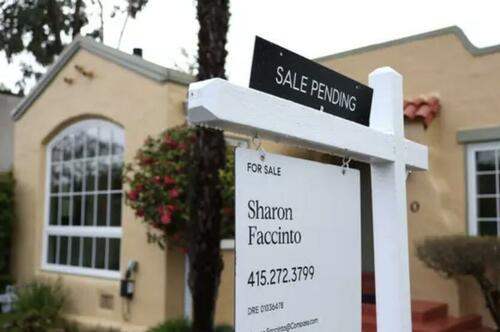
Authored by Bryan Jung via The Epoch Times,
First-time homebuyers are facing some of the highest home prices in years, in the midst of high inflation and mortgage rates, according to a new report.
The strain on household budgets comes in the midst of the ongoing housing shortage, which pushed the cost of starter homes to a record high.
Redfin noted in a July 28 report that first-time buyers need to earn $64,500 per year to afford a home at this point - a $7,200 or 13 percent increase from 2022.
The average sale price of a typical starter home reached $243,000 in June, up 2.1 percent from a year ago and 45 percent above pre-pandemic levels, said the real estate brokerage.
San Francisco, Austin, and Phoenix are currently the only metro regions where home buyers are able to purchase a starter home from below last year's average rates, said Redfin.
Meanwhile, buyers in Miami needed 25 percent more income than last year to afford the average price of a starter home at $300,000.
Home Prices Surge Again This Summer
After a brief cooldown, home prices rose again in much of the country, after the Federal Reserve hiked interest rates again in July to slow inflation.
Meanwhile, the median cost of a home in the United States rose to over $400,000 for the third time on record, according to data from the National Association of Realtors (NAR).
“Homebuyer affordability is still strained this summer, with mortgage rates remaining high and volatile, and home prices high because of low inventory,” said Edward Seiler, an associate vice president at MBA.
Average mortgage rates hit 6.7 percent in June, up from 5.5 percent the year before and just under 4 percent before the pandemic in 2020.
The benchmark 30-year fixed rate mortgage rose slightly last week to 6.81 percent, according to Freddie Mac.
Many potential sellers are reluctant to sell their homes at the risk of a higher mortgage rate when buying a new home, which is a big factor driving the lack of inventory in the market.
“Homeowners that bought a few years ago, at lower prices and at lower interest rates, can feel trapped. If they’ve considered buying a new home, they’ve looked around at today’s higher home prices and also know they can never replace the historically low interest rate they have now,” RubyHome CEO Tony Mariotti said in a statement.
Prices for starter homes continue to rise due to lack of housing stock, amid tight completion and elevated prices across the board.
The amount of new listings for sale in June dropped 23 percent over the last 12 months, the biggest drop since the start of the pandemic.
The total number of starter homes on the market is also down, failing 15 percent since June of last year.
“Buyers searching for starter homes in today’s market are on a wild goose chase because in many parts of the country, there’s no such thing as a starter home anymore,” said Redfin Senior Economist Sheharyar Bokhari in a statement.
The combination of low housing stock, rising prices, and persistently high mortgage rates have continued to push potential buyers out of the market, said Mr. Bokhari.
All of these factors have stifled sales activity, causing purchases of new homes to tumble 17 percent year over year in June.
Most Homebuyers Remain Stuck Out of Market
Average household wages have risen 4.4 percent from a year ago and roughly 20 percent from before the pandemic, but that is not enough for the average buyer to overcome the jump in monthly mortgage payments.
“People who are already homeowners are sitting pretty, comparatively, because most of them have benefited from home values soaring over the last few years,” Mr. Bokhari continued.
“That could lead to the wealth gap in this country becoming even more drastic,” he added.
Home prices have skyrocketed since the pandemic, due to near zero mortgage rates and a massive home buying spree after millions of Americans relocated across the country to work remotely.
Rents have surged as well, putting many prospective first-time homebuyers in a tight spot, with the typical asking rent falling just $24 under last year's $2,053 high.
Wealthier buyers remain the main drivers on the market, as many are able to buy properties in cash without paying a mortgage.
About 36.6 percent of starter homes in the United States were purchased with cash in May, the last month for which data is available.
This is a slight decline from April's decade high and up from 35.2 percent a year earlier.
Declining Inflation May Lead to Lower Mortgage Rates
Fed Chairman Jerome Powell said last week after the last central bank policy meeting that the U.S. housing market will have “a ways to go” before it balances out and prices begin to cool.
Realtor noted in June that demand is still rising as pending home sales data, a forward-looking indicator of home sales based on contract signings, increased for the first time since February.
“The recovery has not taken place, but the housing recession is over,” NAR’s Chief Economist Lawrence Yun said in a statement.
“The presence of multiple offers implies that housing demand is not being satisfied due to lack of supply. Homebuilders are ramping up production and hiring workers.”
He said that the drop in inflation since last year's record high will gradually cause mortgage rates to drop to more reasonable levels.
Mr. Yun said that NAR expects that the 30-year fixed rate mortgage will dip to 6.4 percent this year before declining to 6 percent in 2024.
“With consumer price inflation calming close to the Federal Reserve’s desired conditions, mortgage rates look to have topped out,” Mr. Yun said.
“Given the ongoing job additions, any meaningful decline in mortgage rates could lead to a rush of buyers later in the year and into the next.”
Authored by Bryan Jung via The Epoch Times,
First-time homebuyers are facing some of the highest home prices in years, in the midst of high inflation and mortgage rates, according to a new report.
The strain on household budgets comes in the midst of the ongoing housing shortage, which pushed the cost of starter homes to a record high.
Redfin noted in a July 28 report that first-time buyers need to earn $64,500 per year to afford a home at this point – a $7,200 or 13 percent increase from 2022.
The average sale price of a typical starter home reached $243,000 in June, up 2.1 percent from a year ago and 45 percent above pre-pandemic levels, said the real estate brokerage.
San Francisco, Austin, and Phoenix are currently the only metro regions where home buyers are able to purchase a starter home from below last year’s average rates, said Redfin.
Meanwhile, buyers in Miami needed 25 percent more income than last year to afford the average price of a starter home at $300,000.
Home Prices Surge Again This Summer
After a brief cooldown, home prices rose again in much of the country, after the Federal Reserve hiked interest rates again in July to slow inflation.
Meanwhile, the median cost of a home in the United States rose to over $400,000 for the third time on record, according to data from the National Association of Realtors (NAR).
“Homebuyer affordability is still strained this summer, with mortgage rates remaining high and volatile, and home prices high because of low inventory,” said Edward Seiler, an associate vice president at MBA.
Average mortgage rates hit 6.7 percent in June, up from 5.5 percent the year before and just under 4 percent before the pandemic in 2020.
The benchmark 30-year fixed rate mortgage rose slightly last week to 6.81 percent, according to Freddie Mac.
Many potential sellers are reluctant to sell their homes at the risk of a higher mortgage rate when buying a new home, which is a big factor driving the lack of inventory in the market.
“Homeowners that bought a few years ago, at lower prices and at lower interest rates, can feel trapped. If they’ve considered buying a new home, they’ve looked around at today’s higher home prices and also know they can never replace the historically low interest rate they have now,” RubyHome CEO Tony Mariotti said in a statement.
Prices for starter homes continue to rise due to lack of housing stock, amid tight completion and elevated prices across the board.
The amount of new listings for sale in June dropped 23 percent over the last 12 months, the biggest drop since the start of the pandemic.
The total number of starter homes on the market is also down, failing 15 percent since June of last year.
“Buyers searching for starter homes in today’s market are on a wild goose chase because in many parts of the country, there’s no such thing as a starter home anymore,” said Redfin Senior Economist Sheharyar Bokhari in a statement.
The combination of low housing stock, rising prices, and persistently high mortgage rates have continued to push potential buyers out of the market, said Mr. Bokhari.
All of these factors have stifled sales activity, causing purchases of new homes to tumble 17 percent year over year in June.
Most Homebuyers Remain Stuck Out of Market
Average household wages have risen 4.4 percent from a year ago and roughly 20 percent from before the pandemic, but that is not enough for the average buyer to overcome the jump in monthly mortgage payments.
“People who are already homeowners are sitting pretty, comparatively, because most of them have benefited from home values soaring over the last few years,” Mr. Bokhari continued.
“That could lead to the wealth gap in this country becoming even more drastic,” he added.
Home prices have skyrocketed since the pandemic, due to near zero mortgage rates and a massive home buying spree after millions of Americans relocated across the country to work remotely.
Rents have surged as well, putting many prospective first-time homebuyers in a tight spot, with the typical asking rent falling just $24 under last year’s $2,053 high.
Wealthier buyers remain the main drivers on the market, as many are able to buy properties in cash without paying a mortgage.
About 36.6 percent of starter homes in the United States were purchased with cash in May, the last month for which data is available.
This is a slight decline from April’s decade high and up from 35.2 percent a year earlier.
Declining Inflation May Lead to Lower Mortgage Rates
Fed Chairman Jerome Powell said last week after the last central bank policy meeting that the U.S. housing market will have “a ways to go” before it balances out and prices begin to cool.
Realtor noted in June that demand is still rising as pending home sales data, a forward-looking indicator of home sales based on contract signings, increased for the first time since February.
“The recovery has not taken place, but the housing recession is over,” NAR’s Chief Economist Lawrence Yun said in a statement.
“The presence of multiple offers implies that housing demand is not being satisfied due to lack of supply. Homebuilders are ramping up production and hiring workers.”
He said that the drop in inflation since last year’s record high will gradually cause mortgage rates to drop to more reasonable levels.
Mr. Yun said that NAR expects that the 30-year fixed rate mortgage will dip to 6.4 percent this year before declining to 6 percent in 2024.
“With consumer price inflation calming close to the Federal Reserve’s desired conditions, mortgage rates look to have topped out,” Mr. Yun said.
“Given the ongoing job additions, any meaningful decline in mortgage rates could lead to a rush of buyers later in the year and into the next.”
Loading…





